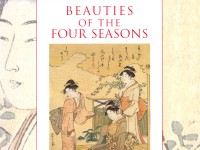Beauties of the Four Seasons
A full catalogue of the Ashmolean’s collection of Japanese bijinga (beautiful women) prints by Mitsuko Watanabe (published Oxford, 2005).

Publications online: 54 objects
- Reference URL
Actions
Okazaki Station
-
Literature notes
At Okazaki-Yado, the 38th station of Tōkaidō from the ‘Bijin Tōkaidō’ series, a beauty stands in the foreground stretching her fingers in a magnificent chrysanthemum pattern winter kimono. In the background is the Yahagi Bidge (approx. 374 metres long) on which people in warm clothing cross the Otogawa River. The castle behind is the Okazaki Castle know as the birthplace of Tokugawa Ieyasu (1554-1616). A similar landscape image is seen in Hiroshige’s Okazaki from the 53 Stations of the Tōkaidō series. -
Description
At Okazaki-Yado, the 38th station of Tōkaidō from the Bijin Tōkaidō (Beauties for the Tōkaidō Road) series, a beauty stands in the foreground stretching her fingers in a magnificent chrysanthemum pattern winter kimono. In the background is the Yahagi Bridge (approximately 374 metres long) on which people in warm clothing cross the Otogawa River. The castle behind is the Okazaki Castle known as the birthplace of Tokugawa Ieyasu (1554-1616). A similar landscape image is seen in Hiroshige’s Okazaki from The Fifty-three Stations of the Tōkaidō Road series.
-
Details
- Series
- Beauties for the Tōkaidō Road
- Associated place
- Date
- 1843 - 1847
- Artist/maker
-
Keisai Eisen (1791 - 1848) (designer)
- Associated people
-
Tsutaya Kichizō (active c. 1830 - 1880) (publisher)
- Material and technique
- nishiki-e (multi-block) woodblock print, with bokashi (tonal gradation), printed with water-based vegetable pigments
- Dimensions
- 39 x 27 cm (height x width)
- Material index
- Technique index
- Object type index
- No. of items
- 1
- Credit line
- Presented by Christ Church College, University of Oxford, 1983.
- Accession no.
- EA1983.76
-
Further reading
Oxford: Ashmolean Museum, 24 August-30 November 2005, Beauties of the Four Seasons, Mitsuko Watanabe, ed. (Oxford: Ashmolean Museum, 2005), no. 37 on p. 78, illus. p. 79
Glossary (3)
kimono, nishiki-e, vegetable pigments
-
kimono
Kimonos, or 'the thing worn' in Japanese, had seasonal designs. The style of kimonos would change four times a year, and winter kimonos would be padded.
-
nishiki-e
Nishiki-e literally means 'brocade pictures' and refers to multi-coloured woodblock prints.
-
vegetable pigments
Vegetable pigments were used to create coloured dyes for Japanese prints, paintings, and textiles. These pigments often faded over time due to the chemical reactions they underwent.
Location
-
- currently in research collection
Objects are sometimes moved to a different location. Our object location data is usually updated on a monthly basis. Contact the Jameel Study Centre if you are planning to visit the museum to see a particular object on display, or would like to arrange an appointment to see an object in our reserve collections.
Publications online
-

Beauties of the Four Seasons
At Okazaki-Yado, the 38th station of Tōkaidō from the ‘Bijin Tōkaidō’ series, a beauty stands in the foreground stretching her fingers in a magnificent chrysanthemum pattern winter kimono. In the background is the Yahagi Bidge (approx. 374 metres long) on which people in warm clothing cross the Otogawa River. The castle behind is the Okazaki Castle know as the birthplace of Tokugawa Ieyasu (1554-1616). A similar landscape image is seen in Hiroshige’s Okazaki from the 53 Stations of the Tōkaidō series.
Notice
Object information may not accurately reflect the actual contents of the original publication, since our online objects contain current information held in our collections database. Click on 'buy this publication' to purchase printed versions of our online publications, where available, or contact the Jameel Study Centre to arrange access to books on our collections that are now out of print.
© 2013 University of Oxford - Ashmolean Museum

